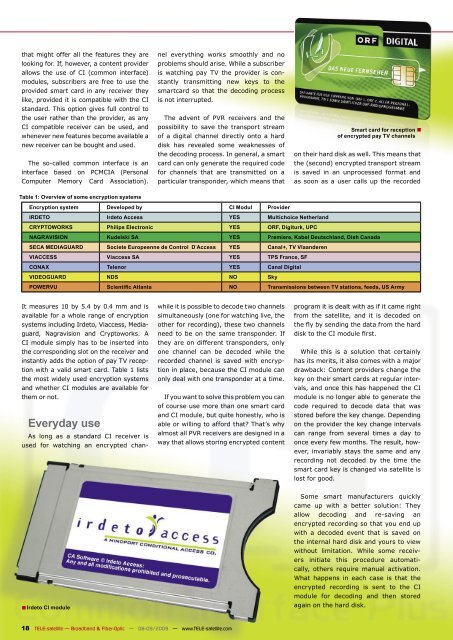08-09 - TELE-satellite International Magazine
08-09 - TELE-satellite International Magazine
08-09 - TELE-satellite International Magazine
Create successful ePaper yourself
Turn your PDF publications into a flip-book with our unique Google optimized e-Paper software.
that might offer all the features they are<br />
looking for. If, however, a content provider<br />
allows the use of CI (common interface)<br />
modules, subscribers are free to use the<br />
provided smart card in any receiver they<br />
like, provided it is compatible with the CI<br />
standard. This option gives full control to<br />
the user rather than the provider, as any<br />
CI compatible receiver can be used, and<br />
whenever new features become available a<br />
new receiver can be bought and used.<br />
The so-called common interface is an<br />
interface based on PCMCIA (Personal<br />
Computer Memory Card Association).<br />
Table 1: Overview of some encryption systems<br />
It measures 10 by 5.4 by 0.4 mm and is<br />
available for a whole range of encryption<br />
systems including Irdeto, Viaccess, Mediaguard,<br />
Nagravision and Cryptoworks. A<br />
CI module simply has to be inserted into<br />
the corresponding slot on the receiver and<br />
instantly adds the option of pay TV reception<br />
with a valid smart card. Table 1 lists<br />
the most widely used encryption systems<br />
and whether CI modules are available for<br />
them or not.<br />
■<br />
Everyday use<br />
As long as a standard CI receiver is<br />
used for watching an encrypted chan-<br />
Irdeto CI module<br />
nel everything works smoothly and no<br />
problems should arise. While a subscriber<br />
is watching pay TV the provider is constantly<br />
transmitting new keys to the<br />
smartcard so that the decoding process<br />
is not interrupted.<br />
The advent of PVR receivers and the<br />
possibility to save the transport stream<br />
of a digital channel directly onto a hard<br />
disk has revealed some weaknesses of<br />
the decoding process. In general, a smart<br />
card can only generate the required code<br />
for channels that are transmitted on a<br />
particular transponder, which means that<br />
while it is possible to decode two channels<br />
simultaneously (one for watching live, the<br />
other for recording), these two channels<br />
need to be on the same transponder. If<br />
they are on different transponders, only<br />
one channel can be decoded while the<br />
recorded channel is saved with encryption<br />
in place, because the CI module can<br />
only deal with one transponder at a time.<br />
If you want to solve this problem you can<br />
of course use more than one smart card<br />
and CI module, but quite honestly, who is<br />
able or willing to afford that? That’s why<br />
almost all PVR receivers are designed in a<br />
way that allows storing encrypted content<br />
18 <strong>TELE</strong>-<strong>satellite</strong> — Broadband & Fiber-Optic — <strong>08</strong>-<strong>09</strong>/20<strong>09</strong> — www.<strong>TELE</strong>-<strong>satellite</strong>.com<br />
Smart card for reception<br />
of encrypted pay TV channels<br />
on their hard disk as well. This means that<br />
the (second) encrypted transport stream<br />
is saved in an unprocessed format and<br />
as soon as a user calls up the recorded<br />
Encryption system Developed by CI Modul Provider<br />
IRDETO Irdeto Access YES Multichoice Netherland<br />
CRYPTOWORKS Philips Electronic YES ORF, Digiturk, UPC<br />
NAGRAVISION Kudelski SA YES Premiere, Kabel Deutschland, Dish Canada<br />
SECA MEDIAGUARD Societe Europeenne de Control D`Access YES Canal+, TV Vlaanderen<br />
VIACCESS Viaccess SA YES TPS France, SF<br />
CONAX Telenor YES Canal Digital<br />
VIDEOGUARD NDS NO Sky<br />
POWERVU Scientific Atlanta NO Transmissions between TV stations, feeds, US Army<br />
program it is dealt with as if it came right<br />
from the <strong>satellite</strong>, and it is decoded on<br />
the fly by sending the data from the hard<br />
disk to the CI module first.<br />
While this is a solution that certainly<br />
has its merits, it also comes with a major<br />
drawback: Content providers change the<br />
key on their smart cards at regular intervals,<br />
and once this has happened the CI<br />
module is no longer able to generate the<br />
code required to decode data that was<br />
stored before the key change. Depending<br />
on the provider the key change intervals<br />
can range from several times a day to<br />
once every few months. The result, however,<br />
invariably stays the same and any<br />
recording not decoded by the time the<br />
smart card key is changed via <strong>satellite</strong> is<br />
lost for good.<br />
Some smart manufacturers quickly<br />
came up with a better solution: They<br />
allow decoding and re-saving an<br />
encrypted recording so that you end up<br />
with a decoded event that is saved on<br />
the internal hard disk and yours to view<br />
without limitation. While some receivers<br />
initiate this procedure automatically,<br />
others require manual activation.<br />
What happens in each case is that the<br />
encrypted recording is sent to the CI<br />
module for decoding and then stored<br />
again on the hard disk.<br />
■

















